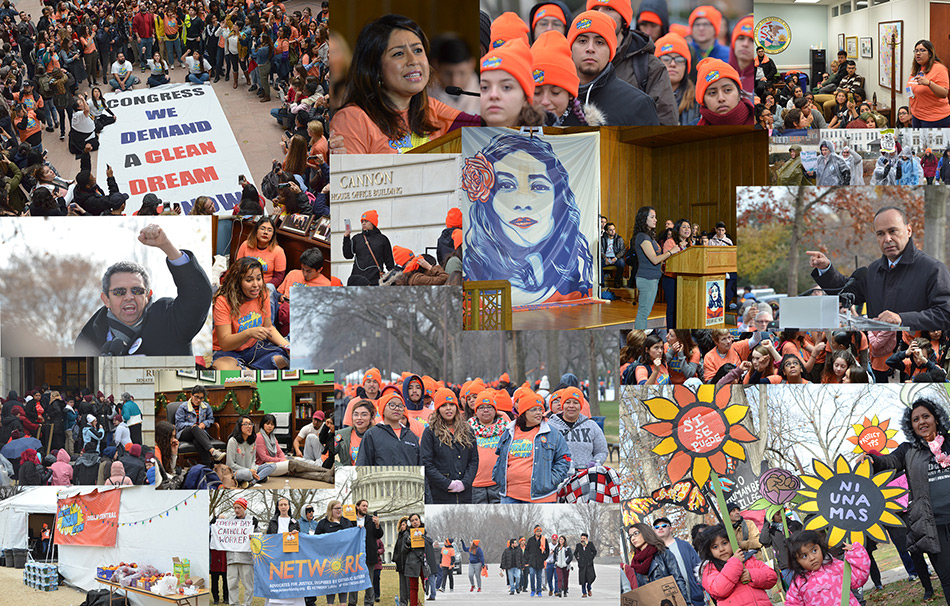|
Copyright © 2018 Eric M.
Appleman/Democracy in
Action.
- Feb.
15, 2018 - DREAMers reject Trump's
four pillars in visits to Senate offices.
- Feb.
14,
2018
- DREAMers deliver Valentine cards to Senate offices.
- Feb.
12,
2018 -
Debate begins in the U.S. Senate.
- Feb. 7, 2018 -
Progressive groups hold "National Day of
Action
for the Dream Act."
Feb. 6,
2018 - Catholic
groups
stage
event
at
the
Capitol
in
support
of
DREAMers.
Jan.
19, 2018
- Undocumented youth protest
in front of RNC headquarters.
The Fight for
a Clean DREAM Act Hits a Wall
(Feb. 2018, updated June
2018) On Sept. 5,
2017 the Trump Administration
announced
its decision to rescind the Deferred Action for Childhood Arrivals
(DACA) program in six months, while calling on Congress to act (1, 2, 3, 4).
DACA,
initiated
by
the
Obama
Administration
on
June
15,
2012
after
continued
congressional
inaction,
was
a
temporary
fix
that
allowed
almost
800,000
young
people
brought
to
the
United
States
unlawfully
to
remain
and
work
here
without
fear
of
deportation. The Trump Administration's action created a sense of
urgency leading up to Mar. 5, 2018. One hundred and twenty two
people were losing
their status each day.
DREAMERs pressed hard for
action in the
form of a "clean Dream Act," meaning legislation unconnected to other
immigration-related issues such as border security. Their
campaign proved to be one of
the most
determined grassroots efforts seen in Washington in recent
decades. Activists engaged in
countless
demonstrations, events and actions large and small on
Capitol Hill and around the country. At the forefront of the
action in
Washington, DC were United We Dream and CASA in Action.
Activists from United We Dream, "the largest immigrant youth-led
network in the country," became a familiar presence in their orange
T-shirts and caps. CASA in Action is "the largest electoral
organization fighting for immigrant rights in the Mid-Atlantic
region." Many other immigrant rights and progressive groups were
also involved.
The initial push aimed to achieve a fix before the end of 2017, seeking
to tie a DACA fix to the short-term continuing resolution to fund the
government. However, Congress left town for the Christmas break
without
acting. Debate intensified in January. On
Jan. 9
Trump convened a high-profile meeting with members of Congress to
discuss immigration. During the meeting he called for "a bill of
love" but also "a bill where we’re able to secure our border" (+).
White House press secretary Sarah Sanders summarized the meeting by
saying four issues were under discussion: border security, chain
migration, visa lottery, and DACA. Coincidentally, late evening
on Jan. 9 another major development occurred: a federal judge ruled
that issued a nationwide injunction against the administration's
termination of DACA; this allowed applications for DACA renewals to
again
be accepted (+).
Despite the promising meeting of Jan. 9, negotiations between the White
House and congressional leaders were bumpy. In a Jan. 11 Oval
Office meeting on immigration, Trump ignited yet another controversy by
reportedly using racist and offensive language (+).
Urged on by activists, Senate Democrats sought to tie immigration to
yet another continuing resolution to fund the government. At one
point Senate Minority Leader Chuck Schumer (D-NY) observed,
"Negotiating with this White House is like negotiating with
Jello. It's next to impossible." After a three-day
government shutdown, Democrats backed down.
On Jan. 25, the administration announced a legislative framework which
included a path to citizenship for DACA recipients and DACA eligible
people, but also emphasized border security, established limits on
family reunification and ended the visa lottery. The proposal met
with generally unfavorable
reactions (+).
On
Feb.
7
congressional
leaders
announced
they
had
reached
a
bipartisan
budget
agreement, but, to the dismay of DREAMers, DACA still was not
addressed. On the plus side for DREAMers, Senate Majority Leader
Mitch
McConnell agreed to an open debate on immigration. However,
Speaker
Paul Ryan did not go as far, prompting House Democratic Leader Nancy
Pelosi to take to the House floor and make a "prayerful human plea to
the Speaker." Pelosi spoke for more than eight hours, a record in
the House. "Give us a vote; what are you afraid of?" she asked
Ryan.
Debate in the Senate started on Feb. 12. The
two sides appeared very far apart, with Democrats favoring a narrow fix
and conservative Republicans advocating legislation similar to Trump's
framework. There was also some
talk of a
short-term measure to protect the DREAMers if a deal could not be
reached. (Of note, on Feb. 13 a second federal judge issued an
injuction preventing the administration from terminating DACA >).
On
the
afternoon
of
Feb.
15
the
Senate
voted
on
four
different
immigration
proposals;
each
fell
short
of
the
requisite
60
votes
needed
to avoid a
filibuster (+). The
next week Congress was in recess for President's Day and that was the
end of it.
The House did vote on a couple of immigration
measures in late June, but both failed.
|


